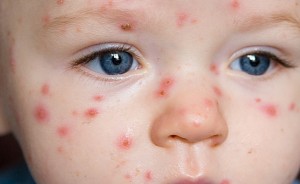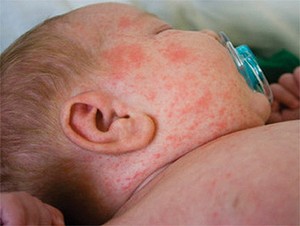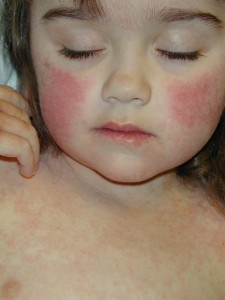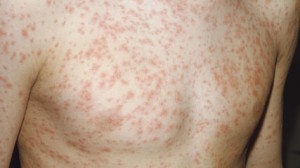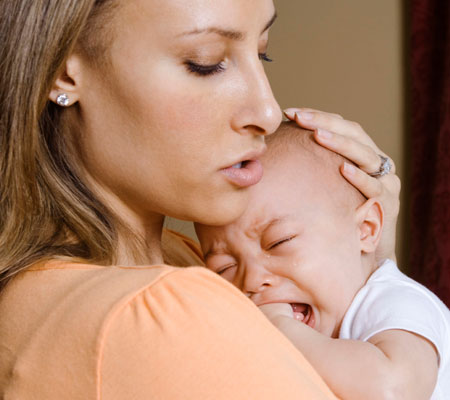
All you need to know about infectious illnesses in babies and children.
Every child gets sick from time to time. When your child isn’t feeling well, you’ll want to know how to recognise the symptoms, how to help, and when to call the doctor. Find out what you need to know about all the common and not so common infections.
Chickenpox
Incubation period: Between 1 and 3 weeks.
Infectious period: The most infectious time is 1-2 days before the rash appears, but it continues to be infectious until all the blisters have crusted over.
It starts with feeling unwell, a rash and a slight temperature.
Spots develop, which are red and become fluid-filled blisters within a day or two. They eventually dry into scabs, which drop off. The spots appear first on the chest, back, head or neck, then spread. Some children have only a few spots, but in others they can cover the entire body. They don’t leave scars unless they’re badly infected.
What to do:
You don’t need to go to your GP or Accident and Emergency (A&E) department unless you’re not sure that its chickenpox or your child is very unwell or distressed.
- Give your child plenty to drink.
- Use paracetamol or ibuprofen to relieve the fever and discomfort.
- Baths, loose comfortable clothes and calamine lotion can all ease the itchiness.
- Try to stop your child scratching or picking at their spots as this will increase the risk of scarring.
It’s hard for children to do this, so give them plenty of praise and encouragement. Distractions, such as TV, are good for taking their mind off the itching. Let the school or nursery know that your child is ill in case other children are at risk.
- Keep your child away from anyone who is pregnant or trying to get pregnant.
If your child had contact with a pregnant woman just before they became unwell, let the woman know about the chickenpox (and suggest that she sees her GP or midwife). In women who’ve never had chickenpox, catching the illness in pregnancy can cause miscarriage or the baby may be born with chickenpox.
How long is chickenpox infectious for?
Someone with chickenpox is infectious from about one to two days before the rash develops, until all the blisters have fully crusted over. This is usually five to six days after the start of the rash.
Measles
Incubation period: 7-12 days.
Infectious period: from around four days before the rash appears until four days after it’s gone.
Symptoms:
The initial symptoms of measles usually appear around 10 days after you become infected and disappear about 7-10 days later.
The initial symptoms can include:
- Cold like symptoms – such as a runny nose, watery eyes, swollen eyelids and sneezing
- Red eyes and sensitivity to light
- A high temperature (fever), which may peak at around 40°C (104°F)
- Tiredness, irritability and a general lack of energy
- Aches and pains
- Dry cough
- Tiny greyish-white spots (called Koplik’s spots) in the mouth and throat
- Loss of appetite
- The illness usually lasts about a week.
Measles is much more serious than chickenpox, German measles or mumps. It’s best prevented (by the MMR vaccination). Serious complications include pneumonia and death.
What to do:
- Make sure your child gets plenty of rest and plenty to drink (warm drinks will ease the cough).
- Give them paracetamol or ibuprofen to relieve the discomfort and fever.
- Put Vaseline around their lips to protect their skin.
- If their eyelids are crusty, gently wash them with warm water.
- If your child is having trouble breathing, is coughing a lot or seems drowsy, see your GP urgently.
Mumps
Incubation period: 14-25 days.
Infectious period: from a few days before starting to feel unwell until the swelling goes down.
Symptoms:
- A general feeling of being unwell.
- A high temperature.
- Pain and swelling on the side of the face in front of the ear and under the chin. Swelling usually begins on one side, followed (though not always) by the other side.
- Discomfort when chewing.
Mumps is spread in the same way as colds and flu – through infected droplets of saliva that can be inhaled or picked up from surfaces and transferred into the mouth or nose.
A person is most contagious a few days before the symptoms develop and for a few days afterwards.
During this time, it’s important to prevent the infection spreading to others, particularly teenagers and young adults who have not been vaccinated.
If you have mumps, you can help prevent it spreading by regularly washing your hands with soap, using and disposing of tissues when you sneeze, and avoiding school or work for at least five days after your symptoms first developed.
What to do:
- Give your child paracetamol or ibuprofen to ease pain in the swollen glands. Check the pack for the correct dosage.
- Give your child plenty to drink, but not fruit juices as they make the saliva flow, which can make your child’s pain worse.
- There’s no need to see your GP unless your child has stomach ache and is being sick, or develops a rash of small purple or red spots or bruises.
Your child’s face will be back to normal size in about a week. It’s rare for mumps to affect boys’ testes (balls). This happens more often in adult men with mumps. If you think your child’s testes are swollen or painful, see your GP.
Parvovirus B19 (also known as fifth disease or slapped cheek disease)
Incubation period: 1-20 days.
Infectious period: a few days before the rash appears (children are no longer contagious when the rash appears).
Symptoms:
- It begins with a fever and nasal discharge.
- A bright red rash, like the mark left by a slap, appears on the cheeks.
- Over the next two to four days a lacy rash spreads to the trunk and limbs.
- Children with blood disorders such as spherocytosis or sickle cell disease may become more anaemic. They should seek medical care.
What to do:
- Make sure your child rests and drinks plenty of fluids.
- Give them paracetamol or ibuprofen to relieve the discomfort and fever.
- Pregnant women or women planning to become pregnant should see their GP or midwife as soon as possible if they come into contact with the infection or develop a rash.
German measles (Rubella)
Incubation period: 15-20 days.
Infectious period: from one week before the rash first appears until at least five days after it’s gone.
Symptoms:
- It starts like a mild cold.
- A rash appears in a day or two, first on the face, then on the body. The spots are flat (on light skin they’re pale pink).
- Glands in the back of the neck may be swollen.
- Your child won’t usually feel unwell.
What to do:
Give your child plenty to drink. Keep them away from anybody who’s in the early stages of pregnancy (up to four months) or trying to get pregnant. If your child has had contact with any pregnant women before you knew about the illness, you must let the women know as they’ll need to see their GP.
Whooping cough
Incubation period: 6-21 days.
Infectious period: from the first signs of the illness until about six weeks after coughing starts. If an antibiotic is given, the infectious period will continue for up to five days after starting treatment. Antibiotics need to be given early in the course of the illness in order to improve symptoms.
The condition usually begins with a persistent dry and irritating cough that progresses to intense bouts of coughing. These are followed by a distinctive ‘whooping’ noise, which is how the condition gets its name.
The coughing can last for around three months (another name for whooping cough is the ‘hundred day cough’).
Symptoms:
- The symptoms are similar to a cold and cough, with the cough gradually getting worse.
- After about two weeks, coughing bouts start. These are exhausting and make it difficult to breathe.
- Younger children (babies under six months) are much more seriously affected and can have breath-holding or blue attacks, even before they develop a cough.
- Your child may choke and vomit.
- Sometimes, but not always, there will be a whooping noise as the child draws in breath after coughing.
- The coughing fits may continue for several weeks, and can continue for up to three months.
What to do:
- Whooping cough is best prevented through immunisation.
- If your child has a cough that gets worse rather than better and starts to have longer fits of coughing more and more often, see your GP.
- It’s important for the sake of other children to know whether or not your child has whooping cough. Talk to your GP about how to look after your child. Avoid contact with babies, who are most at risk from serious complications.
Get blog updates by email
Enter your detials:
Get updates by email
Enter your detials:
